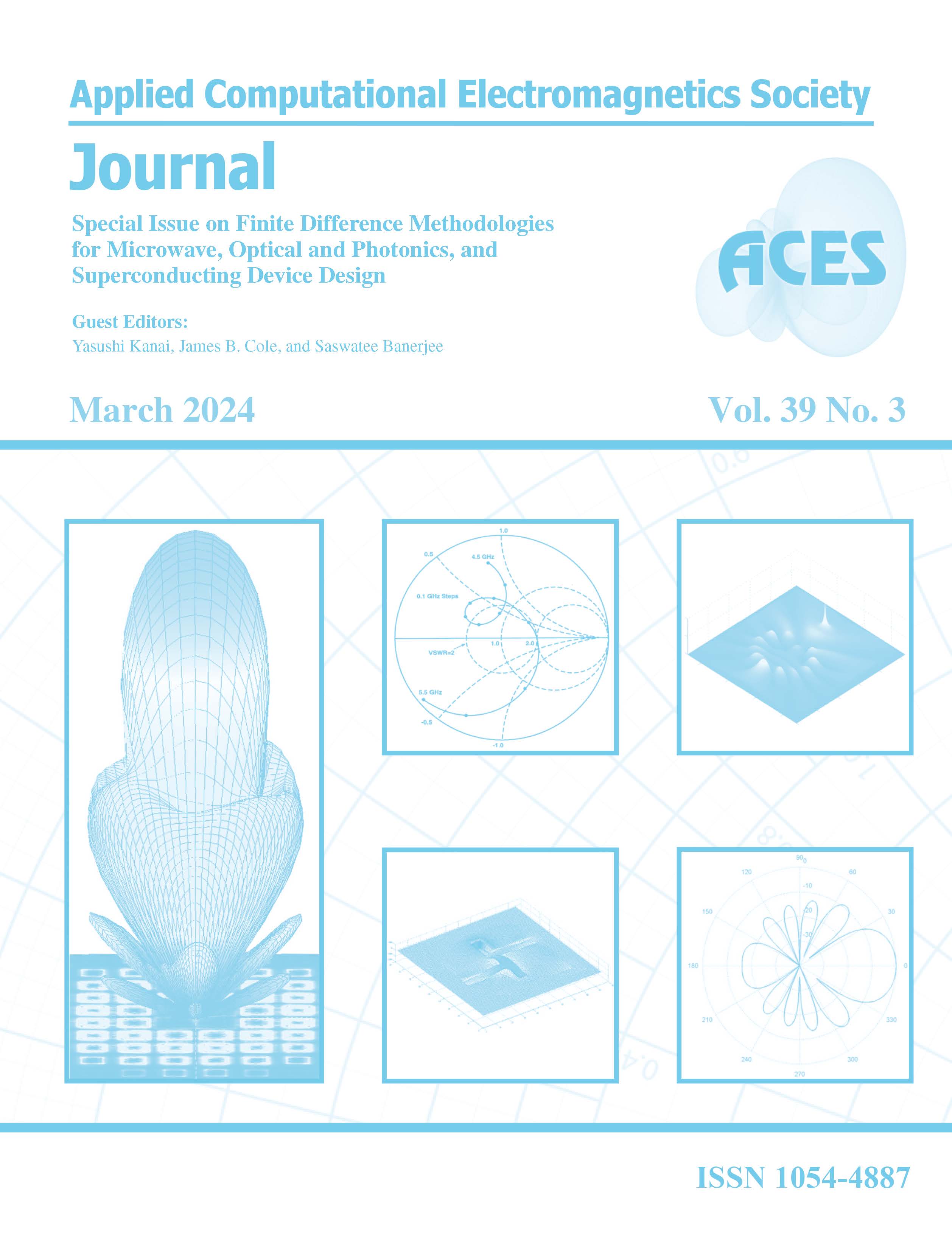A Simple, Method of Moments Solution for the Integral Equations for Multiple Dielectric Bodies of Arbitrary Shape in Time Domain
DOI:
https://doi.org/10.13052/2024.ACES.J.390305Keywords:
dielectric bodies, integral equations, method of moments, time domainAbstract
In this work, we present a straightforward and simple method of moments (MOM) solution procedure, with minimum mathematical manipulations, to solve the coupled integral equations for multiple, homogeneous and inhomogeneous, dielectric bodies of arbitrary shape directly in the time domain. The standard surface and volume integral equation formulations are used for homogeneous and inhomogeneous bodies, respectively. The numerical solution procedure does not involve a time-marching process as is usually adopted for time domain problems and seems to be one of the primary reasons for the late-time instabilities as a result of error accumulation. The present solution method is stable for a very long time as evidenced by several representative numerical examples presented for validation.
Downloads
References
K. S. Yee, “Numerical solution of initial boundary value problems involving Maxwell’s equations in isotropic media,” IEEE Transactions on Antennas and Propagation, vol. 14, pp. 302–307, 1966.
K. S. Yee, J. S. Chen and A. H. Chang, “Conformal finite-difference time domain (FDTD) with overlapping grids,” IEEE Transactions on Antennas and Propagation, vol. 40, pp. 1068–1075, 1992.
R. Gomez, J. A. Morente and A. Salinas, “Time domain analysis of an array of straight-wire coupled antennas,” IEE Electronic Letters, vol. 22, pp. 316–318, 1986.
R. Gomez, A. Salinas, A. R. Bretones, J. Fornieles and M. Martin, “Time domain integral equations for EMP analysis,” International Journal of Numerical Modeling, vol. 4, pp. 153–162, 1991.
R. Gomez, A. Salinas and A. R. Bretones, “Time domain integral equation methods for transient analysis,” IEEE AP-S Magazine, vol. 34, pp. 15–22, 1992.
S. M. Rao and D. R. Wilton, “Transient scattering by conducting surfaces of arbitrary shape,” IEEE Transactions on Antennas and Propagation, vol. 39, pp. 56–61, 1991.
D. A. Vechinski, S. M. Rao, and T. K. Sarkar, “Transient scattering from three-dimensional arbitrarily shaped dielectric bodies,” Journal of the Optical Society of America, vol. 11, pp. 1458–1470, 1994.
G. Manara, A. Monorchio, and R. Reggiannini, “A space-time discretization criterion for a stable time-marching solution of the electric field integral equation,” IEEE Transactions on Antennas and Propagation, vol. 45, no. 3, pp. 527–533, Mar. 1997.
N. Gres, A. Ergin, E. Michielssen and B. Shanker, “Volume integral equation based electromagnetic scattering from three-dimensional inhomogeneous dielectric objects,” Radio Science, vol. 36, pp. 379–386, 2001.
B. Shanker, K. Aygun, and E. Michielssen, “Fast analysis of transient scattering from lossy inhomogeneous dielectric bodies,”Radio Science, vol. 39, RS2007, doi:10.1029/2003RS002877, 2004.
G. Kobidze, J. Gao, B. Shanker, and E. Michielssen, “A fast time domain integral equation based scheme for analyzing scattering from dispersive objects,” IEEE Transactions on Antennas and Propagation, vol. 53, pp. 1215–1226, 2005.
S. M. Rao, “A simple and efficient method of moments solution procedure for solving time-domain integral equation - Application to wire-grid model of perfect conducting objects,” IEEE Journal on multiscale and multiphysics computational techniques, vol. 4, pp. 57–63, Mar. 2019.
S. M. Rao “A straight-forward method of moments procedure to solve the time domain integral equation to PEC bodies via triangular patch modeling,” ACES Journal, vol. 35, pp. 843–854, Aug. 2020.
R. Harrington, Time Harmonic Electromagnetic Fields, New York: IEEE Press, 2001.
R. Harrington, Field Computation by Moment Methods, New York: Macmillan, 1968.
S. M. Rao, Time Domain Electromagnetics, London: Academic Press, 1999.
S. M. Rao, D. R. Wilton, and A. W. Glisson, “Electromagnetic scattering by surfaces of arbitrary shape,” IEEE Transactions on Antennas and Propagation, vol. 30, pp. 409–418, 1982.
D. H. Schaubert, D. R. Wilton, and A. W. Glisson, “Tetrahedral modeling method for electromagnetic scattering by arbitrarily shaped inhomogeneous dielectric bodies,” IEEE Transactions on Antennas and Propagation, vol. 32, pp. 77–85, 1984.




